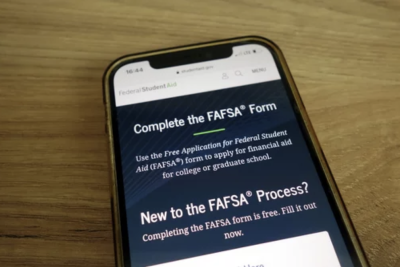While taking on any debt isn't ideal, student loans may be the one thing you need to cover the balance of your tuition and college expenses after grants, scholarships and savings have been applied. The choice to incur debt shouldn’t be taken lightly, but for many students it allows them to pursue their higher education goals.
Additionally, student loans often allow you to borrow money at interest rates that are lower than loans not intended for education. And you may be able to defer interest payments until after you graduate.
That being said, it’s important to evaluate your loan options and understand loan terminology before deciding which type of loan is right for you. Remember, you'll need to repay your student loan(s). Here are some things to consider before taking on student debt.
Are Student Loans Right for You?
After you submit your Free Application for Federal Student AID (FAFSA) and receive your financial aid packages from prospective colleges, you’ll not only want to pay attention to the amount of grants and scholarships you’ve been awarded, but also note your student loan eligibility.
Just because you’re eligible for student loans doesn’t mean you need to take them out. However, they could be a good option for you if you don’t qualify for scholarships or grants, or don’t receive enough to meet all your tuition and related college expenses. Graduate or professional students also tend to be more likely to take on student loans, or students who enroll at a college or university out-of-state.
How Much Should you Borrow?
It's important that you only borrow what you can afford to pay back. If your student loans equal more than eight percent of your overall income before taxes, you may begin to have difficulty paying other bills, qualify for additional loans or save money. A good rule of thumb is to avoid burrowing more than your anticipated starting annual salary. Research potential careers and their salaries and use that data to set a ceiling for borrowing.
NOTE: You may be able to combine your federal loans through a loan consolidation program. This can reduce the size of your monthly payments by extending your repayment period. You also can learn more about how financial aid works and your aid options by attending a financial aid events at your high school or prospective colleges.
Paying for College
This guide explains the several financial aid options available to pay for college and how to make them work for you.
Types of Loans
There are a variety of loan options that may be available to both you and your family from the federal and state governments as well as private lenders. Here is a closer look at some of those options:
Federal Perkins Loans
The Federal Perkins Loan Program provides long-term, low interest loans to undergraduate and graduate students who demonstrate financial need and enroll at least half time at participating schools. You must also be a U.S. citizen or eligible non-citizen, and meet certain conditions to receive federal aid.
How Much Money Can You Get?
The loan amount depends on the availability of funds at your school, your financial need and the amount of other aid you receive.
- Undergraduate students may borrow up to $5,500 per year and $27,500 in total.
- Graduate and professional students may borrow up to $8,000 per year and $60,000 in total.
- Students studying abroad may be eligible to borrow larger amounts.
What's The Application Process?
You apply to the financial aid office at the school you attend. Not all schools participate in the Perkins Loan Program. Each school has its own application deadline and serves as the loan's lender. The Perkins Loans do not have an origination fee.
What's The Repayment Process?
You begin repaying the loan nine months after you graduate or leave school. If you return to school, you have six months before you start repaying on previous loans. You may be allowed up to 10 years to repay your loan. The amount of the monthly payment depends on the size of the debt and the length of the repayment period.
Part or all of the loan can be deferred or canceled under certain conditions, such as:
- If you teach children with disabilities.
- If you teach full-time in a designated elementary or secondary school that serves low-income students.
You must seek approval for these provisions from your school.
Federal Direct Stafford Loans
The federal government makes subsidized and unsubsidized Stafford loans to students attending participating schools across the country. The U.S. Department of Education is the lender.
The main difference between subsidized and unsubsidized Stafford Loans is that the subsidized loans are available only to those who can demonstrate financial need, and the interest is paid by the government while the student attends school at least half time. With the unsubsidized loans are available to students regardless of financial need, and the student pays the interest while enrolled.
If you encounter words you don't understand, visit the loan terminology page and reference it while you read.
Direct Subsidized Stafford Loans
Who Is Eligible?
To be eligible for the Federal Direct Subsidized Stafford Loan, you must attend school at least half time and be determined to have financial need. You also must meet certain conditions to receive federal aid. The amount you can receive depends on whether you are a dependent or independent (self-supporting) student, and your academic level.
After you sign a promissory note, your loan will be sent to your school, either by electronic funds transfer or by check made payable to both you and your school. Most loans are disbursed to you in two or more payments, rather than a lump sum. Because of this, you should plan your personal finances accordingly
What's The Application Process?
You apply any time during the year, but obtaining a loan may take several weeks. There are two basic methods of application – paper and electronic. Your school will tell you which method it prefers. Each method begins with filing the Free Application for Federal Student Aid (FAFSA).
If a need analysis has already been performed for you by the school, you might arrange a loan in two to four weeks. If no need analysis has been done, it could take several months. Therefore, be sure to:
- Plan ahead and ask your school which application method it prefers, and how long it will take to apply.
- Find out whether you're eligible for a Federal Pell Grant. This is required before your school can process the loan application and disburse loan funds.
- Be sure you understand the loan repayment terms.
What Is The Interest Rate?
The interest rate on the Federal Direct Subsidized Stafford Loan depends on when you took out the loan:
- Undergraduate students: If the first disbursement of your subsidized loan is between July 1, 2012 and June 30, 2013, the interest rate on your loan is fixed at 3.4 percent. A fee of 1 percent is deducted from each disbursement.
- The federal government will pay (or subsidize) the interest on the loan while you are enrolled on at least a half-time basis. In most cases, you must begin repaying the loan six months after you leave school or drop below half-time status. Typically, you have up to 10 years to complete repayment.
The amount of your payment depends on the size of your debt. However, you will pay at least $50 per month in principal and interest. Under certain conditions you may defer (postpone) payments for up to three years. Ask your financial aid administrator or read your promissory note to obtain information about deferring payment.
Direct Unsubsidized Stafford Loans
For students without demonstrated financial need, an unsubsidized Federal Stafford Loan is available. The interest rate on Direct Unsubsidized Loans is fixed at 6.8% for all borrowers (undergraduate and graduate). A fee of 1% is deducted from each disbursement.
Borrowers of the Unsubsidized Stafford Loan are required to pay interest on the loan while in school.
You may make monthly or quarterly interest payments to your lender or you may choose to have your interest added to the principal of the loan. This is called "capitalization." This can occur during:
- The grace period -the time before beginning repayment.
- Periods of authorized deferment –postponement.
- Periods of forbearance -authorized delay in loan principal payment.
Repayment Plans:
Four repayment plans are available to borrowers with either subsidized or unsubsidized loans:
- The Standard Repayment Plan requires a fixed amount (at least $50) to be paid each month for up to 10 years.
- The Income Contingent Repayment Plan bases the monthly repayment amount on annual income, family size and the loan amount.
- The Income-Based Repayment Plan bases payments on total federal loan payments as a percentage of income.
- The Extended Repayment Plan allows the borrower to extend repayment over a period of 12 to 30 years, depending on the loan amount.
- Under the Graduated Repayment Plan, payments are lower at the beginning of the repayment period and then increase every two years over 12 to 30 years.
For more information, call (800) 848-0979 or visit www.direct.ed.gov/.
Federal Direct plus Loan
The Federal Parent Loans for Undergraduate Students (PLUS) program provides loans through the government to parents of dependent undergraduate students and students in graduate and professional programs participating in the Direct Loan Program.
Who Is Eligible?
PLUS borrowers do not have to show need for the program, but will have their credit checked. Borrowers may borrow up to the cost of attendance minus any other financial aid received. There is no cap on annual or aggregate borrowing amounts.
Direct Plus Loans
Loans made on or after July 1, 2006 have a fixed interest rate of 7.9%. There is a 4% fee deducted with each disbursement.
What Are Your Repayment Options?
Repayment of both principal and interest begins within 60 days of receiving the loan and extends from five to 10 years. For loans disbursed on or after July 1, 2008, the borrower has the option to delay the principal repayment start date until after the student graduates. The amount borrowed will determine the minimum monthly payment, but no payment will be less than $50 per month
Borrowers can choose a standard, extended or graduated repayment plan.
Federal & State Health Professions Programs
The Minnesota Department of Health's Office of Rural Health and Primary Care administers loan forgiveness programs for the following health professionals:
- rural and urban physicians: primary care residents or students (family practice, internal medicine, OB/GYN, pediatrics, psychiatry)
- Mid-level practitioners: nurse practitioner students, physician assistant students, certified nurse midwife students, nurse anesthetist students or advanced clinical nurse specialist students
- Nurses: licensed practical nurse students or registered nurse students
- Dentists: dental students or licensed dentists
- Pharmacists: students or residents in a pharmacy program or licensed pharmacists
- Allied Health Care Tech Faculty: students studying to become allied health care instructors
- Nurse Faculty: Students studying to become nursing instructors
Federal & State Health Professions Programs Applications
Applications for these programs are available after July 1 of each year and due December 1, and can be requested from:
Minnesota Department of Health
Office of Rural Health and Primary Care
Tel: (651) 201-3870 or (800) 366-5424 (Minnesota only)
Webpage: www.health.state.mn.us/divs/orhpc/funding/loans/index.html
Federal Health Professions Programs
Various federal scholarship and loan programs are available for students interested in health professions, such as nursing, dentistry, pharmacy, optometry or medicine. Campus-based programs include the Health Professions Student Loan Program, the Primary Care Loan Program, Loans for Disadvantaged Students Program and Nursing Student Loan Program.
Additional health loan repayment programs may be available from the U.S. Department of Health and Human Services.
To apply, students should contact the financial aid office at the school where they intend to apply or where they are enrolled.
For more information, visit www.hrsa.gov/loanscholarships/ or e-mail flrpinfo@hrsa.gov with questions.
Alternative Loans
Alternative loans are available from private lenders, such as banks, savings and loan associations or credit unions. Typically, these loans cost the student and family more in the long run, but they may have fewer eligibility restrictions.
For more information, contact commercial financial institutions or the financial aid administrator at the school you are attending or are planning to attend.




